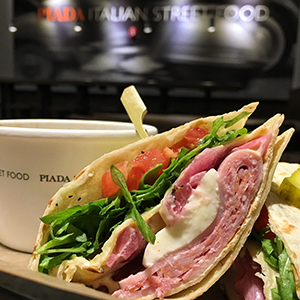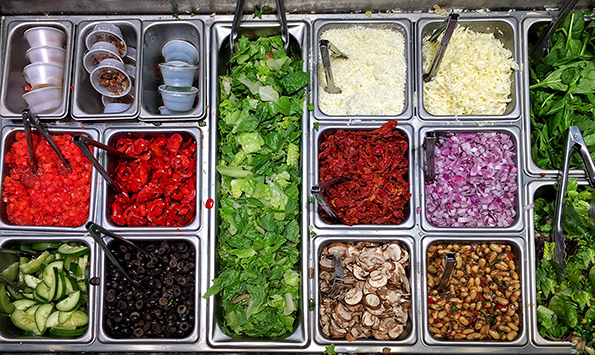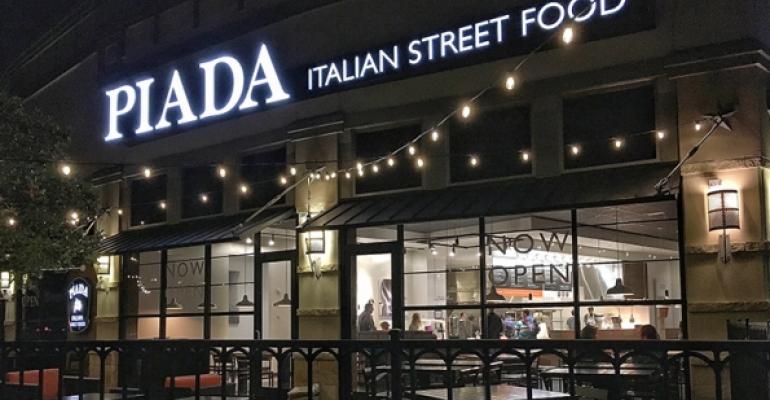Shortly before opening time earlier this week at Piada Italian Street Food’s newest location in a Minneapolis suburb, the entire staff gathered at the front counter for a meeting.
To Chris Doody, the fast-casual chain’s founder and CEO, who was at a table in the dining area, the meeting illustrates one of the unseen efforts that differentiates Piada from its competitors. It’s an element that the chain and the people who run its restaurants brought with them from the fine-dining sector to improve service.
“You rarely see a pre-shift meeting in fast-casual,” Doody said. “They talk about hospitality and treating people right, ensuring they’re able to answer the questions of the customers in the queue.”

Doody believes that this effort, which he says extends to Piada’s food, will help the chain break through the highly competitive Italian sector while continuing to ride the fast-casual growth wave.
Doody founded Piada in 2010, four years after he sold Bravo Brio Restaurant Group Inc. He developed the concept over several months, after studying chains like Chipotle and making visits to Rimini, Italy, where he ate Italian wrap-style sandwiches known as piadinas, or piadas. His goal was to bring an edgier Italian chain to fast casual.
The piadas served at the concept are burrito-like flatbread wraps filled with a selection of proteins, sauces, cheeses and other items. The flatbread is warmed on a cast-iron grill at the counter and the piada is constructed in front of the customer. While options include traditional steak and chicken, they also include fresh salmon and calamari, which are not typically offered on fast-casual menus.
The chain’s first unit exploded out of the gate, generating $2.7 million in revenue in its first year, setting the stage for the company to quickly open additional units. It had 14 locations by 2013 when it received a major investment from the private-equity group now known as L Catterton, which has since re-upped its commitment.

Now Piada is targeting new markets well beyond its Ohio home. The chain’s newest locations in Texas and Minnesota open beachheads in those states where it hopes to prove its model. The company is also targeting Florida as a future market, hoping to bank on that state’s love of fast-casual chains — Doody said fast-casual restaurants have higher unit volumes in Florida than they do elsewhere.
“This is a great opportunity for us to test the brand outside our core market,” Doody said. “We’ve proven the concept can work well in Ohio and in surrounding states. This is going to be an important market.”
Still, he said, the company is careful with the pace of its expansion. “The key is not growing too fast,” Doody said. “We have to execute at a high level. It’s got to be great.”
But that expansion will also depend on the chain’s ability to break through a competitive Italian landscape at a time when many existing noodle-focused and Italian-centric concepts are struggling — including the concepts at Doody’s previous company, Bravo Brio.
Doody suggested that part of the reason is that consumers perceive traditional Italian food as “heavy.” The chain’s goal is to “distance itself from traditional Italian,” he said.
“The perception is that Italian food is heavy,” he said. “In Italy, it’s not. And you can eat here and not feel like you have to take a nap.”
Doody also suggested that the chain’s uniqueness — no other concept of any size specializes in piadas — might also work to its advantage. “Nobody’s done anything unique in Italian for a long time,” he said.
To be sure, it requires some customer training. Employees often greet customers when they arrive to describe what the chain is about. Piada also supplements its menu with salads, soups and noodles.
While customers can tailor their orders, Piada director of culinary Matt Harding said it typically takes them a few visits before they feel confident enough to build their own meal.
To ensure that Piada operates more like a full-service concept on a daily basis, it has lured chefs with full-service backgrounds to be operating partners. The company attracts them with the promise of working for a growth chain, as well as the ability to operate an easier concept — fast-casual restaurants have a third of the employees that a full-service restaurant employs.
“They have a higher understanding of service,” Doody said. “They’re used to dealing with the guests on a high level.”
He also said the “high level” extends to its dining room, where Piada has specially-made wood tables and other elements to give the concept a more upscale feel. “We could buy cheap tables,” Doody said, “but it wouldn’t feel as nice.”
Still, Doody said Piada isn’t where he wants to be, and he strives to keep improving the concept.
“We haven’t figured it out yet,” he said. “In my opinion, we’re not finished. We’re still tweaking many things.”
Contact Jonathan Maze at [email protected].
Follow him on Twitter: @jonathanmaze

